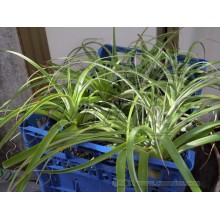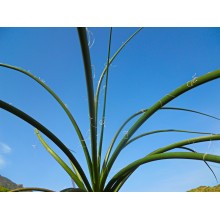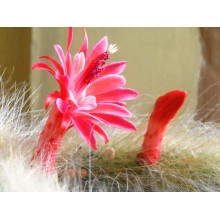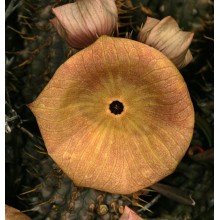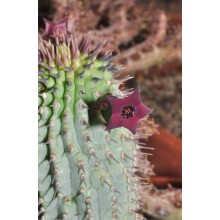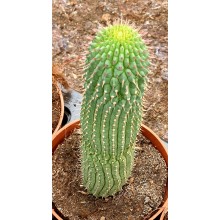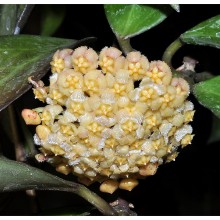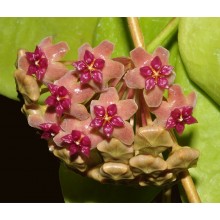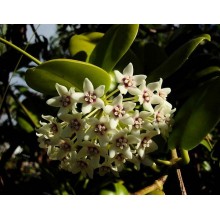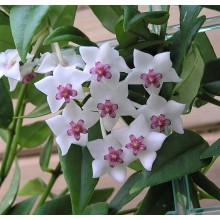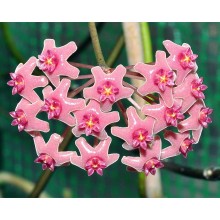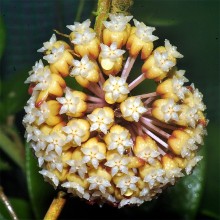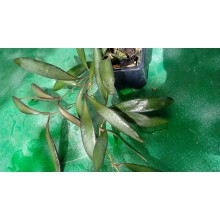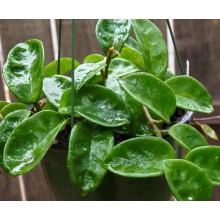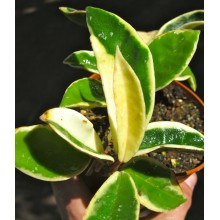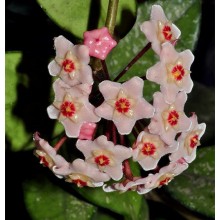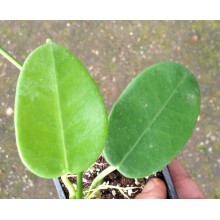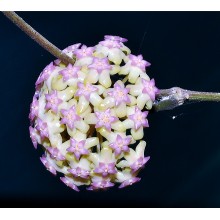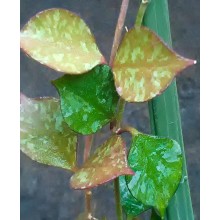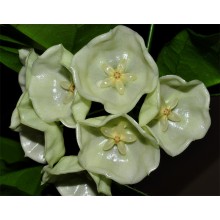Succulents There are 628 products.

World deserts and dry areas are home to the most interesting plants. Canarius offers an increasing selection of succulent plants of maximum quality, because they are grown outdoors, under the full sun of the Canary Islands.
Succulents or "fat plants" are water-retaining species, adapted to dry conditions. They store succum (juice, water) in their leaves, stems or roots, and often show a stout and fleshy appearance.
Subcategories
-
Agave
Agave is a genus of succulent plants from America. Some species grow in cold areas and take hard frost, while some others live in tropical climates. Some are tiny dwarfs and some are giants, up to 2 or 3 m wide.
Cold hardy agaves can create an exotic effect in your garden. Agave species make fine companions to palms or cacti. Variegated agaves are incredibly sought after by collectors. Our web shop offers an ever changing selection of species. We ship bare rooted plants, unless otherwise specified.
-
Aloe, Gasteria & Haworthia
Aloe, Gasteria and Haworthia are three related genera, comprising hundreds of succulent plants. They are all easily grown in pots. A few adapt to low-light levels of indoor conditions and can be grown as house plants.
- Aloe is a genus of about 400 species, native to Africa, Arabia and Madagascar. Small or dwarf aloes are becoming especially popular in colder climates as they can be taken indoors during the hardest months.
- Gasteria includes some 80 species endemic to South Africa, known for their spectacular leaves which are glossy, mottled and textured. They bloom in Spring-Summer with long spikes of small orange flowers. Some species are so variable that we offer particular clones from specific locations.
- Haworthia is a genus endemic to South Africa with about 70 species and a number of local subspecies, varieties and forms. Leaves are often banded, speckled, dotted, or semi-translucent and show wide variations.
-
Crassulaceae
This is a new, growing section of species from the family Crassulaceae. There are about 1,400 species in 33 genera and their distribution is worldwide, but mostly occur in the Northern Hemisphere and Southern Africa, especially in dry habitats. Here you can buy healthy, sun-hardened plants grown in the Canary Islands and shipped to your home.
-
Mesembs
This group of desert plants is briefly named Mesembs because they belong to a botanical family formerly named Mesembryanthemaceae. There are almost 2.000 species, mainly found in Southern Africa, with extreme adaptations to dry habitats. Some are called "living stones", as they look like pebbles. Many are easy to grow and their main need is full sun. Some are difficult because they grow in truly extreme areas.
Our Web Shop offers sun grown healthy plants, with compact and colourful leaves. Some plants are sold as cuttings, and others as rooted plants, of at least two years old.
-
Sansevieria
Recently assigned to the family Asparagaceae, the genus Sansevieria counts about 70 species, nearly all native to Africa, Arabia and Madagascar. Perennial herbs adapted to dry habitats with stiff, succulent leaves, their length ranges from a few centimeters to 2 meters. Sansevieria trifasciata and its many cultivars are among the most popular houseplants, popularly called mother in law's tongue. A well grown plant usually produces a spike of many white, richly scented flowers and then orange berries. Even the rarest species are resistant to neglect, provided you keep them from frost in winter and scorching sun in summer.
-
Hoya
Hoyas are twining vines, with showy exotic flowers, from the rainforests in Asia and Oceania. Most species grow in bright shade or morning sun, but they will also grow indoors as house plants. They are well suited for baskets, trellises or ladders. They tolerate a few weeks of drought but they are sensitive to frost and cold. Many hoyas are easy to grow and bloom, while some are tricky and rare.
-
Asclepiads
Asclepiads or Asclepiadoideae are a subfamily in the Apocynaceae, with about 2900 species. There are lots of leafless stem succulents but also perennial herbs, shrubs, lianas or rarely trees. They produce remarkable flowers, for the complex mechanisms they have developed for pollination. Many species produce an unusual fragrance, often called "carrion", and attracts flies for pollination. -
Caudiciforms
These plants from dry areas produce an unusually thick stem, the caudex. They are also called pachycauls and they have a disproportionately thick trunk, often with few branches. The caudex can be hidden underground, but in most cases they grow upwards, forming spectacular trees. The largest caudiciforms in the world are the baobabs. -
Other succulents
Here you will find all those species of desert plants that are not included in their own category. We will place here all plants from unusual families, other than Agaves, Aloes, Crassulaceae, Sansevieria, Mesembs, Epiphytic cacti, etc.
-
Hechtia tillandsioides
Hechtia tillandsioides
This is an unusual and elegant terrestrial bromeliad with spineless silvery leaves. Leaves are soft and velvety to touch. Established plants will bloom with huge "sprays" of pink flowers. Hechtia tillandsioides is native to Mexico (States of Hidalgo and Mexico). It takes frost and feels at home in Mediterranean climates !
21,50 € -
Hesperaloe parviflora
Hesperaloe parviflora
Leaves are decorated by showy white, curly fibres on the margins. It clumps slowly and Long-lasting tall, red inflorescences appear in summer. Hardy to all types of conditions and it can take drought, and frost to about -20 C !
15,00 € -
Hildewintera colademononis
Hildewintera colademononis
Beautiful cactus from the Andes with hanging stems. They are "hairy", coated with a grey fur. Flowers are a show indeed! Cola de Mono means Monkey Tail and this is because each stem looks like the hanging tail of a hidden monkey! It is a high-elevation species and it is cool-growing and frost-tolerant.
13,50 € -
Hoodia gordonii
Hoodia gordonii
Beautiful branched Hoodia from Botswana, South Africa and Namibia. It has become also popular as a medicinal plant, since it reputedly works as an appetite suppressant.
26,30 € -
Hoodia mossamedensis
Hoodia mossamedensis
Purple-black, star-shaped flowers, with a flat corolla with recurved tips and a blackish corona.
41,00 € -
Hoodia pillansii
Hoodia pillansii
This hoodia is different in its genus because of its thicker stems, less branched. It blooms with yellow-maroon flowers. It is native to an area Prince Albert, in South Africa. Some authors consider it a synonym of H. gordonii.
16,20 € -
Hoya aldrichii
Hoya aldrichii
Pink on pink! This species is endemic to the remote Christmas Island. Its flowers show a delicate contrast of dark pink on pale pink, Each flower grows up to 15 mm in diameter.
27,00 € -
Hoya australis
Hoya australis
Australian hoya found on rainforest margins and rocky areas, with white fragrant blooms. It is easy to grow and somehow cold-tolerant, even though it does better if protected from frost.
11,90 € -
Hoya carnosa 'Krinkle 8'
Hoya carnosa 'Krinkle 8'
This select clone of the popular Hoya carnosa has some pecultiar beautifully crinkled, leaves, with regular bumps on dark green blades. It is also a prolific bloomer and umbels well placed on the foliage.
21,50 € -
Hoya carnosa 'Queen Princess'
Hoya carnosa 'Queen Princess'
Green leaves with white margins.
11,30 € -
Hoya curtisii
Hoya curtisii
Small leaved Hoya, native to Philippines, Malaysia, and Thailand. Leaves are marbled with silver, green, purple and more. Flowers are unusual in shape, white with a pink center.
21,00 € -
Hoya danumensis
Hoya danumensis
Very beautiful Hoya, native to Borneo. Its flowers are pure white, and quite large, about 4 cm tall. It is rare in cultivation and hard to root, but then it is easy to grow and blooms regularly during the warmest months. It has a subtle fragrance but the beauty and size of the flowers deserve attention!
44,00 €
At the moment there are few products in this category Succulents

























